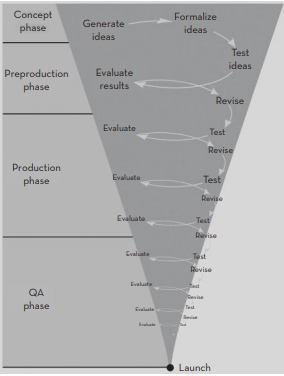Game Development
also known as: Agile Game Development
Intent
- Develop a complete game (a level is just part of the game).
- Understand the game development process, its complexity, and the importance of simplifying it.
- Recognize that game development is a work-intensive process and utilize repeatable game objects and textures to reduce the need for constant recreation of art assets (Totten 2019 - An Architectural Approach of Level Design, p.90-91).
Problem
- Every game starts with an idea, but how do you organize a team to implement those ideas into a unique and enjoyable game?
- Level design is just a small part of the whole game development process, so it’s essential to understand what game development encompasses to successfully connect levels to the entire game.
- Two approaches exist: the waterfall approach and an agile approach. This process describes an agile approach that aligns with agile product management principles, iterating continuously to refine the scope.
Process Steps: Seven Stages of Game Development
1. Planning (Concept phase)
- Define the game idea.
- Address key questions: 2D or 3D? Core mechanics? Aesthetic? Story? Target audience? Platform?
- Input: Ideas and motivation for creating a game.
- Application: Collaborate as a team to decide the game’s concept.
- Output: Written or visualized game ideas, development process plan, key decisions.
- Roles: #roles/manager Manager, #roles/designer Designer.
- Relevant Tools: Communication Tools, Digital Collection Tools, Digital Diagram Tools, Non-digital Design Tools.
- Relevant Methods: High Concept, Lenses, Pillars, Goals and Features
2. Pre-Production
- Define the game’s scope.
- Focus on game design with the application of various methods.
- Develop the game concept in detail and align story, art, and technical aspects.
- Input: The concept from the planning phase.
- Application: Collaboratively design a detailed game concept that seamlessly transitions into the production phase.
- Output: Documentation summarizing all decisions and plans for application in the production phase.
- Roles: Everyone, including #roles/manager Manager, #roles/designer Designer, #roles/engineers Engineer, #roles/artists Artist, #roles/writer Writer.
- Relevant Tools: Communication Tools, Digital Art Tools, Digital Diagram Tools, Non-digital Design Tools.
- Relevant Methods: [[ Methods/High Concept ]], Reference Collection, Mood Boards, Pacing Diagram, Drawing a Map, Molecule Diagram, Paper Prototype, Proximity Diagram, Game Design Document, and more.
3. Production
- Implement the concept, design ideas, and decisions.
- The project takes shape in this phase.
- This phase consumes the most time.
- Input: Materials from previous stages.
- Application: Produce all necessary game components for an engaging player experience.
- Output: The game, after several iterations.
- Roles: #roles/designer Designer, #roles/artists Artist, #roles/engineers Engineer, #roles/writer Writer.
- Relevant Tools: Computational Tools, Game Engines, Digital Art Tools, Communication Tools, Digital Collection Tools.
- Relevant Methods: Massing, Nintendo Power Method, Gym Scene.
4. Testing
- Test all elements developed so far.
- Iterative Game Design: Each iteration involves playtesting, evaluation, and revisions.
- Agile game development iterates continuously, reducing bugs and changes (see iterative game design image).
 (Source: [[ Game Design Workshop.pdf ]])
(Source: [[ Game Design Workshop.pdf ]])
- Input: Game segments or the entire game for testing.
- Application: Play and test the game comprehensively, focusing on different aspects such as mechanics, pacing, and the integration of artwork and animations. Consider inspiration from Software Testing for guidance. Release alpha versions for player feedback.
- Output: An evaluation of the game, potentially documented.
- Roles: #roles/tester Tester, #roles/player Player.
- Relevant Tools: Game Engines, Communication Tools, Digital Collection Tools.
- Relevant Methods: Game Design Document, Critical Path Analysis, Nintendo Power Method, Gym Scene.
5. Pre-Launch
- Market and advertise the game.
- Generate hype to attract players on the release date.
- Roles: #roles/manager Manager.
6. Launch
- Release the game.
- Ensure all bugs are fixed, and the game offers an enjoyable experience before launch.
- Be prepared for unexpected issues, such as server problems for online modes.
- Roles: #roles/player Player.
7. Post-Production
- Ongoing work after launch.
- Address post-launch bugs.
- Plan future updates and additional content to keep players engaged.
- Consider future sequels.
- Player feedback is vital.
- Roles: #roles/manager Manager, #roles/designer Designer, #roles/engineers Engineer, #roles/artists Artist, #roles/tester Tester, #roles/player Player.
Applicability
- Suits agile development well. For a waterfall approach see this blog: https://www.gamedeveloper.com/business/waterfall-game-development-done-right
- Leans on the Software Engineering Workflow and can therefore manage small and big teams.
- Only serves as an introduction to agile game development. The topic is too big to fit it in one page. See https://www.gamedeveloper.com/production/agile-game-development-with-scrum-teams for a more in-depth look at game development with scrum teams.
Pros and Cons
Pros:
- Short iteration circles that uncover problems early
- Efficient game development
- Steps are easy to follow
Cons:
- Falls short in more rigid structures that might prefer a waterfall model
- Is only in theory. Every game development looks different and unique.
- Might focus too much on the production phase and doesn’t put emphasis on the management actions.
Related Processes
- Closely related to Software Engineering Workflow because game development is just another form of software development.
- Includes smaller processes like Combat Design, Iterative Map Design and Gamespace Prototyping in the pre-production and production phase.
Relevant Literature
Game Design Chapter 7: Gameplay
...
Notes mentioning this note
Behavior Diagram
also known as: Behavioral Diagram, Dynamic View, Activity Diagram, Use Case Diagram, State Machine Diagram, …?
Molecule Diagram
also known as:
Classification
#method
#medium/diagram
#medium/graph
#medium/visual
#tools/non-digital
#tools/digital
#process/planning
#process/designing
#roles/designer
#roles/engineers
#roles/artists